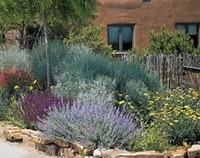Restricted Trees for Pollen Control
Certain trees may not be planted within the city limits of Albuquerque. There is a penalty for violating the provisions of this ordinance.
There is no approved plant list. The only plants prohibited or restricted are detailed below.

Worst trees for pollen?
One person may be allergic to a small amount of Mulberry pollen, while another may be allergic to a large amount of Ash pollen.
For the City of Albuquerque, the primary tree pollen producers are listed below.
| Rank | Tree | Highest Daily Pollen Count Range |
|---|---|---|
| 1 | Mulberry | 395-10205 |
| 2 | Juniper | 726-2480 |
| 3 | Elm | 69-1065 |
| 4 | Ash | 76-959 |
| 5 | Cottonwood | 52-730 |
NOTE: These results are from 14 years of data.
What Trees are Prohibited?
- All Cypress, of the family Cupressaceae, genus Cupressus
- All Mulberry, of the family Moraceae, genus Morus
What Trees have Exceptions?
Juniper/Cedar
It is OK to buy and plant:
- male plants that do not exceed 2 feet tall when mature, or
- any size plant that is female only.
It is OK to grow and sell:
- male plants that meet the above criteria and are properly labeled prior to sale.
Cottonwood/Poplar
All Cottonwood/Poplars are restricted except for the following trees:
- Populus fremonti var. Wizlizenzii - Rio Grande Cottonwood
- Populus tremuloides - Quaking Aspen
- Populus acuminata - Lanceleaf or Mountain Cottonwood
- All trees must be labeled as high pollen/high allergen potential.
NOTE: Male trees produce the pollen. Female trees produce the cotton.
Sycamore and Ash
No restriction, except that all trees sold within the City limits must:
- be individually labeled identifying them as high pollen/high allergen potential.
Elm
All Elm are restricted except for the following trees:
- Dioecious Ulmus parviflora (Chinese elm; Lace bark elm) - must be individually labeled as high pollen/allergen potential.
- Ulmus americana-ascendens (American elm)
- Ulmus glabra-horizontals (Horizontal elm)
- Ulmus minor-gracilis
NOTE: These elm trees have been shown to be Dutch Elm disease resistant.
Other Trees
The amended ordinance states that any other non-flowering and non-pollen producing trees may be sold and planted within the City.
What to Look for When Buying Trees
- All nurseries within the City limits, from the small local grower to the large chain, may not sell prohibited trees and must properly label restricted trees as noted in the 1994 Ordinance and the 2004 Amendment.
- If the tree is an Elm, Juniper, Cedar, Sycamore, or Ash, then the tree should be properly labeled as required. Check with the nursery staff if you have any questions concerning the tree you are about to purchase.
- If you want to limit the amount of pollen in your landscape, you should research what trees and plants fit your criteria. The key to remember is that male trees produce the pollen, so you may limit your landscape to female only where possible. The exception to the female only rule is that some trees are monecious (also monoecious), meaning they are both male and female and therefore produce pollen.
- The majority of tree pollen will likely be deposited within a few hundred feet of the tree. To limit pollen in your home, you should not plant trees near air conditioning, windows, vents, or other openings to your home. It is appropriate to consider your neighbors prior to planting new trees and consider how potential pollen may be an impact.
- It is a violation to purchase a prohibited tree outside the city limits, transport the tree to your home and have the prohibited tree planted within the city limits.
